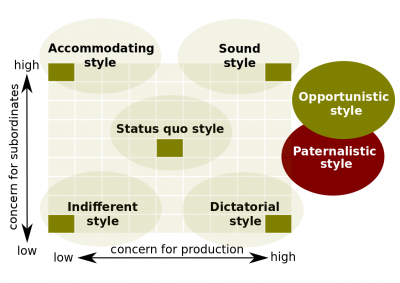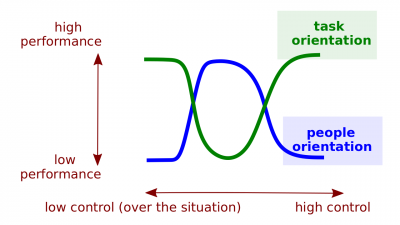Difference between revisions of "Fiedler contingency model"
(Created page with "Managerial grid (hereinafter, the ''Grid'') is #400px|thumb|right|[[Full Range Leadership Model]]'''Full Range Leadership Model'''. A...") |
|||
| Line 1: | Line 1: | ||
| − | + | [[File:Leadership-styles.png|400px|thumb|right|[[Full Range Leadership Model]]]]'''[[Full Range Leadership Model]]'''. A model that depicts seven managerial [[leadership style]]s on a continuum: (1) [[laissez-faire style|laissez-faire]], (2) [[management by exception]], (3) [[contingent reward leadership]], (4) [[individualized consideration]], (5) [[intellectual stimulation]], (6) [[inspirational motivation]], and (7) [[idealized influence]]. | |
| − | |||
| − | |||
| − | |||
#*[[Laissez-faire style]]. Leadership style of someone who lets the group make decisions and complete the work in whatever way it sees fit. | #*[[Laissez-faire style]]. Leadership style of someone who lets the group make decisions and complete the work in whatever way it sees fit. | ||
#[[File:Managerial-grid.png|400px|thumb|right|[[Managerial grid]]]]'''[[Managerial grid]]'''. A two-dimensional grid for appraising [[leadership style]]s. | #[[File:Managerial-grid.png|400px|thumb|right|[[Managerial grid]]]]'''[[Managerial grid]]'''. A two-dimensional grid for appraising [[leadership style]]s. | ||
| − | + | [[File:Fiedler-contingency.png|400px|thumb|right|[[Fiedler contingency model]]]][[Fiedler contingency model]] (hereinafter, the ''Model'') is a model that suggests that effective group performance depends on the proper match between a leader's orientation, whether he or she is [[task orientation|task-oriented]] or [[Human relations orientation|people-oriented]], and the degree to which the situation allows the leader to control and influence. The ''model'' (1) uses a [[least preferred coworker questionnaire]] to classify leaders, (2) assumes that leaders cannot be both [[task orientation|task-oriented]] or [[Human relations orientation|people-oriented]], and (3) suggests that [[Human relations orientation|people orientation]] is the best match to the situations with moderate control, while those leaders who are [[task orientation|task-oriented]] best perform in situations with high or low control. | |
| − | |||
| − | |||
| + | *[[Least preferred coworker questionnaire]]. An instrument that purports to measure whether a person is task or relationship oriented. The ''questionnaire'' has initially been developed for the [[Fiedler contingency model]]. | ||
==Related coursework== | ==Related coursework== | ||
Revision as of 10:19, 20 November 2018
Full Range Leadership Model. A model that depicts seven managerial leadership styles on a continuum: (1) laissez-faire, (2) management by exception, (3) contingent reward leadership, (4) individualized consideration, (5) intellectual stimulation, (6) inspirational motivation, and (7) idealized influence.
- Laissez-faire style. Leadership style of someone who lets the group make decisions and complete the work in whatever way it sees fit.
- Managerial grid. A two-dimensional grid for appraising leadership styles.
Fiedler contingency model (hereinafter, the Model) is a model that suggests that effective group performance depends on the proper match between a leader's orientation, whether he or she is task-oriented or people-oriented, and the degree to which the situation allows the leader to control and influence. The model (1) uses a least preferred coworker questionnaire to classify leaders, (2) assumes that leaders cannot be both task-oriented or people-oriented, and (3) suggests that people orientation is the best match to the situations with moderate control, while those leaders who are task-oriented best perform in situations with high or low control.
- Least preferred coworker questionnaire. An instrument that purports to measure whether a person is task or relationship oriented. The questionnaire has initially been developed for the Fiedler contingency model.


